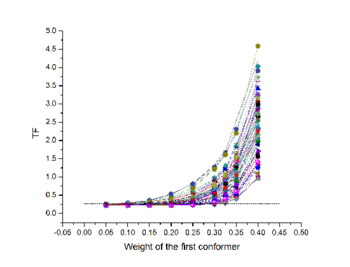User:Enrico Ravera/Sandbox 1
From Proteopedia
Maximum Occurrence (MO) refers to a method for making rigorous numerical assessments on the conformational space of flexible biological macromolecules[1].
Background
Flexible proteins, even in the simplest case of two rigid domains linked by a flexible region, may sample a wide conformational space. Such variety makes their study by X-ray crystallography difficult, because it may yield the structure of a single conformation trapped in the crystal, if crystals are obtained at all. Solution techniques such as Nuclear Magnetic Resonance (NMR) and Small-Angle Scattering of both X-rays and Neutrons (SAXS and SANS), provide experimental observables averaged over many conformation with different weights. The problem of recovering the conformational ensamble that generated the data from the data themselves is an ill-defined inverse problem that admits an infinite number of solutions. The Maximum Occurrence is the maximum percent of time that a conformer of a macromolecule can exist and still be compatible with the experimental data (see Figure 1).
This is an evolution of a previous approach where few conformations having maximum allowed probability (MAP) were looked for[2].
Case Study: Calmodulin
Maximum Occurrence profiles were calculated for N60D Calmodulin[3](PDB ENTRIES 1sw8,2k0j,2k61). Calmodulin is a two-domain protein experiencing high mobility in the central region[4][5]. Paramagnetic NMR restraints as pseudocontact shift (PCS) and self-orientation residual dipolar couplings (RDC) provided further insight in the description of such conformational heterogeneity[6]. (PDB ENTRIES 1sw8,2k0j,2k61)
Bibliography
- ↑ Bertini I, Giachetti A, Luchinat C, Parigi G, Petoukhov MV, Pierattelli R, Ravera E, Svergun DI. Conformational Space of Flexible Biological Macromolecules from Average Data. J Am Chem Soc. 2010 Sep 7. PMID:20822180 doi:10.1021/ja1063923
- ↑ Bertini I, Gupta YK, Luchinat C, Parigi G, Peana M, Sgheri L, Yuan J. Paramagnetism-based NMR restraints provide maximum allowed probabilities for the different conformations of partially independent protein domains. J Am Chem Soc. 2007 Oct 24;129(42):12786-94. Epub 2007 Oct 2. PMID:17910448 doi:10.1021/ja0726613
- ↑ Bertini I, Gelis I, Katsaros N, Luchinat C, Provenzani A. Tuning the affinity for lanthanides of calcium binding proteins. Biochemistry. 2003 Jul 8;42(26):8011-21. PMID:12834353 doi:10.1021/bi034494z
- ↑ doi: https://dx.doi.org/10.1021/bi00138a005
- ↑ doi: https://dx.doi.org/10.1021/bi00403a011
- ↑ Bertini I, Del Bianco C, Gelis I, Katsaros N, Luchinat C, Parigi G, Peana M, Provenzani A, Zoroddu MA. Experimentally exploring the conformational space sampled by domain reorientation in calmodulin. Proc Natl Acad Sci U S A. 2004 May 4;101(18):6841-6. Epub 2004 Apr 20. PMID:15100408 doi:10.1073/pnas.0308641101

